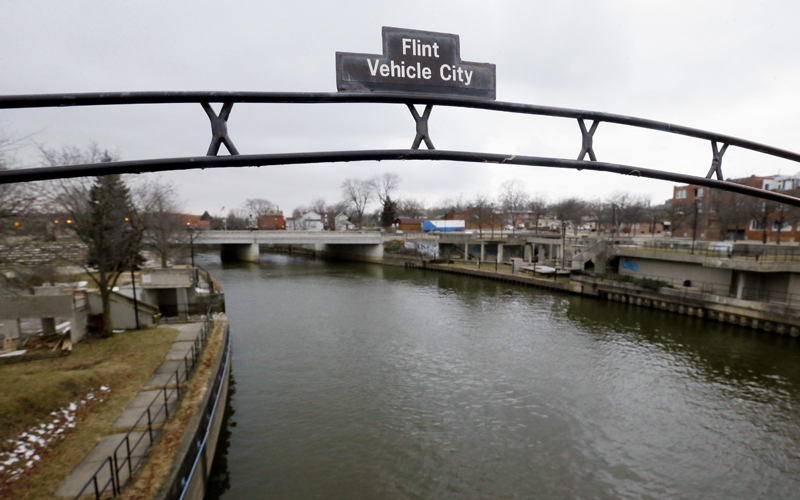
On this episode of the Global News podcast What happened to…?, journalist Erica Vella revisits the Flint Michigan water crisis.
The Flint Michigan water crisis had garnered international attention in 2015 after it was discovered that residents of the city were being poisoned by the water running through their taps.
The crisis began in 2014, when the city of Flint switched its water source from the Detroit water system to the Flint River; it was supposed to be a cost-saving solution.
The Karegnondi Water Authority was in the process of building a pipeline from Lake Huron but it hadn’t been completed yet; it was decided that the city would temporarily use water from the Flint River instead of continuing to get water from Detroit until the pipeline was completed.
Many people living in the city had questioned the decision before the switch.

“There had been stories about the Flint River for many years; it’s not a place you want to drink the water from, even though you might want to look at it and put your toes in it,” said resident E. Yvonne Lewis.
READ MORE: New lawsuit seeks replacement of Flint, Michigan’s lead pipes
The switch officially happened on April 25, 2014, and Lewis said she remembers noticing an immediate difference when the water was switched.
“The water looked funny, the water smelled funny when it started coming out of the tap. When that switch happened, almost immediately you could see, feel and taste the difference,” said Lewis.
“We had community members going to the doctor for unusual rashes and hair falling out and experiencing different kinds of illnesses that we couldn’t even understand. I remember sitting in meetings with infectious disease doctors and they’re saying these are some things that are not usual in an urban city,” Lewis said.

For months, residents had tried to get the attention of local and state officials to show them the water that was coming through their taps.
“There were many people that started standing up and they would actually take bottles of water, 16oz plastic bottles or even gallon jugs of water to city hall, raise those jugs during council meetings and say we got a problem,” she said.
Residents had begun reporting various illnesses as well and several people had died from a Legionnaires outbreak.
Melissa Mays said she was one resident who had gotten ill.
“I started having bone pain. I’m like, why can I feel my bones? This is weird. I was exhausted and my hair was falling out,” she said.
Mays said she was motivated to help and started collecting water samples from residents in the city.
“We started going around passing out water bottles and finding that there were these high levels of lead,” she said.
It was later revealed that the city didn’t treat the water with anti-corrosion agents that might have prevented the aged pipes from leaching lead — from the solder that binds the copper and iron pipes together — into the water system.
READ MORE: Obama drinks filtered tap water in Flint, Michigan to show it’s safe
“If you imagine there some pipes within water system pipes and other fixtures that are either made of lead or that are made of other metals that can contain lead and water naturally corrodes metal. So, as water rushes through pipes, there are some breaking off, flaking dissolution of the lead into the pipes,” said Sarah Tallman, senior lawyer with the Natural Resources Defense Council.
“These chemicals help build up a scale on the inside of the pipe, and that protective scale prevents lead from leaching from the pipe surface into the water. And so those chemicals are often referred to as corrosion-control chemicals. And so one of the ways that water systems can reduce the risk of lead contamination is to add these kinds of chemicals to the water.”
The city would be switched back to the Detroit water system in October 2015, but seven years later, residents are still dealing with the aftermath of the crisis.
On this episode of Global News’ What happened to…? Erica Vella revisits the water crisis to find out how it all began and what has happened since. She also speaks with the community members who pushed for change and finds out where they are now.
Contact:
Email: erica.vella@globalnews.ca
If you enjoy What Happened To…? please take a minute to rate it on Apple Podcasts or Google Podcasts, tell us what you think and share the show with your friends.
If you haven’t subscribed yet — what are you waiting for?
Subscribing’s easy! Here’s how…

- Open the Apple Podcasts app, search for “What Happened To?” and select it from the list of results.
- Once on the What Happened To? page, click the “subscribe” button to have new episodes sent to your mobile device for free.
- Click the name of an episode from the list below to listen.

- Open the Spotify app, search for “What Happened To?” and select it from the list of results.
- Once on the What Happened To? page, click the “Follow” button to have new episodes sent to your mobile device for free.
- Click the name of an episode from the list below to listen.




Comments